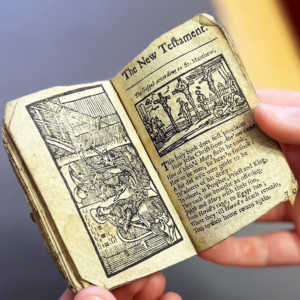 By Isobel, Work Experience Student
By Isobel, Work Experience Student
As a sixth-form student at Torquay Girls’ Grammar School, I came to the Cathedral Library and Archives this week to do some work experience. Whilst looking at some of the rare old books in the collection, I was especially struck by this miniscule, much-loved children’s book.
Measuring only a couple of inches in length, and dating back about three hundred years, it would have been used to teach children how to read while also instilling Christian values into them from a young age. It tells an impressively abbreviated version of the Holy Bible (at one point condensing all one hundred and fifty psalms into only half a page), interspersed with crude woodcut prints. Most notably, the New Testament begins with a whole-page print depicting the birth of Christ, opposite a smaller representation of his crucifixion. These were designed to help keep the children entertained, much like picture books today.
Miniature formats of the Bible came as a result of the 16th century Protestant reformation, which championed the idea that people could access the Bible for themselves – the idea quickly grew in popularity, and before long the Bible was required reading. This new popularity prompted the printing of abbreviated versions, of which this book is an early example.
It was very common for children to sign or scribble in their books, and this book is no exception. In December 1826, John Trislade Nichols claimed this copy, labelling it ‘His Book’ along with a signature; however, the book has undoubtedly passed through many other small hands and small pockets during its extensive lifetime. Though a little battered and evidently cheaply made, it remains remarkably legible and accessible to the modern eye.